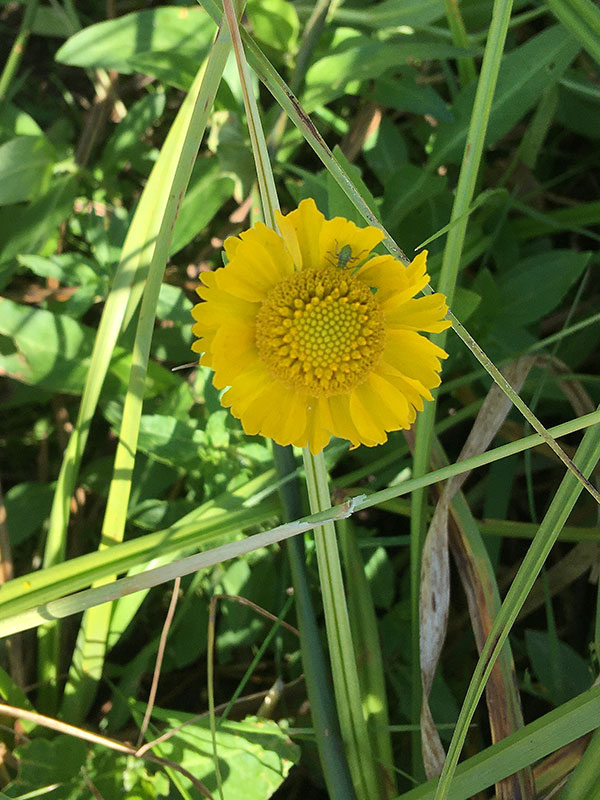Helenium autumnale / common sneezeweed
- 2″ flower head with nearly spherical central disk; numerous yellow rays
- found in moist areas in full or partial sun
- sessile or clasping lance shaped leaves on an angled and winged stem
Also known as: Helen’s flower, bitterweed, autumn sneezeweed, false sunflower
Synonyms: Helenium canaliculatum, H. latifolium, H. parviflorum
Sneezeweed is a perennial almost immediately identifiable by its bulbous center flower disk – nearly spherical and projecting above a skirt-like whorl of ray florets (petals). The bright yellow petals droop away from the central disk which, for what it’s worth, is not as bright as the rays. The plant’s stem branches near the top, resulting in up to 100 flowers on each plant. Flower heads are about 2 inches across.
Add to this the green-ish winged stems and you can erase any doubt you had. Sneezeweed is found in every state except Alaska and almost every Canadian province, so you are unlikely to be out of its natural range.
Sneezeweed leaves are lance-shaped to narrowly oval and have very few if any teeth. They can be up to 5 inches long. They are either sessile or clasp the stem.
For the habitat, the key word is moisture. Like… moist meadows in wooded areas or along rivers, moist open woodlands, soggy thickets, fens, poorly drained pastures, low areas along streams or ponds, ditches… or the landing place at Big Eddy. It will be in full or partial sun, not in the understory. It is common to find the plant growing within a few feet of water regardless of the rest of the habitat details. This matches with the root system being fibrous and shallow.
Interesting bits: The common name is not derived from any allergy producing effect (like ragweed)… the pollen grains are large and not wind dispersed. Rather, pollination is associated with a number of insect vectors, especially various species of bee. Instead, the common name is based on historic use of the crushed dried leaves and flower heads to make a form of snuff that caused sneezing. In certain cultures and times, sneezing was regarded as a desirable way to rid the body of evil spirits or a way to loosen up a head cold. That, I guess, made a sneeze-producing remedy desirable. I imagine it is not addictive like tobacco snuff might be.
On the other hand, common sneezeweed leaves, flowers, and seeds are poisonous to humans, causing gastric and intestinal irritation… basically anyplace with mucous membranes. This can become fatal to us, to sheep, to dogs and fish. The offending compounds are “sesquiterpene lactones”. These are generally common in the Aster family, and may deter both pathogens and herbivores.
For what it’s worth, sneezeweed has been cultivated and is sold in nurseries (somewhere), but it must be kept moist and can get gangly.
Sneezeweed has been featured as the Plant of the Week by the USFS. The writeup is interesting and the source of some of the material on this page.
| Color | |
|---|---|
| Family | |
| Blossom size | |
| Inflorescence size | |
| Inflorescence type | |
| When? | |
| Where? |

